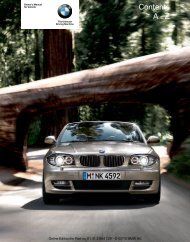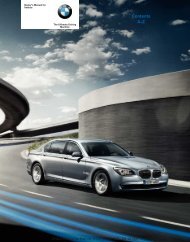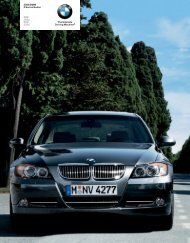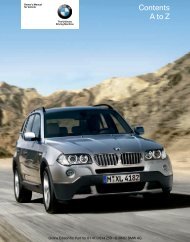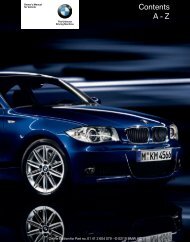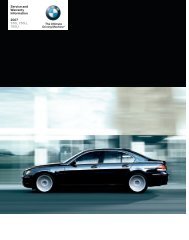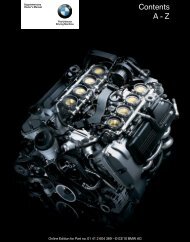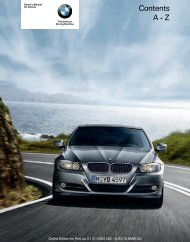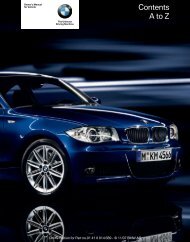2011 3 Series Owner's Manual without iDrive - Irvine BMW
2011 3 Series Owner's Manual without iDrive - Irvine BMW
2011 3 Series Owner's Manual without iDrive - Irvine BMW
Create successful ePaper yourself
Turn your PDF publications into a flip-book with our unique Google optimized e-Paper software.
Things to remember when driving<br />
Hydroplaning<br />
When driving on wet or slushy roads,<br />
reduce road speed. If you do not, a wedge<br />
of water can form between tires and road surface.<br />
This situation, known as hydroplaning,<br />
means that the tire can completely lose contact<br />
with the road surface, so that neither the car can<br />
be steered nor the brake be properly applied.<<br />
The risk of hydroplaning increases with declining<br />
tread depth on the tires, refer also to Minimum<br />
tread depth on page 141.<br />
Driving through water<br />
Drive through water on the road only if it is<br />
not deeper than 1 ft/30 cm, and then only<br />
at walking speed at the most. Otherwise, the<br />
vehicle's engine, the electrical systems and the<br />
transmission may be damaged.<<br />
Use the parking brake on inclines<br />
On inclines, do not hold the vehicle for a<br />
lengthy period using the clutch; use the<br />
parking brake instead. Otherwise, greater<br />
clutch wear will result.<<br />
For more information about the drive-off assistant,<br />
refer to page 82.<br />
Braking safely<br />
Your <strong>BMW</strong> is equipped with ABS as a standard<br />
feature. Applying the brakes fully is the most<br />
effective way of braking in situations in which<br />
this is necessary. Since the vehicle maintains<br />
steering responsiveness, you can still avoid<br />
possible obstacles with a minimum of steering<br />
effort.<br />
Pulsation of the brake pedal, combined with<br />
sounds from the hydraulic circuits, indicate that<br />
ABS is in its active mode.<br />
Driving in wet conditions<br />
When roads are wet or there is heavy rain,<br />
briefly exert gentle pressure on the brake pedal<br />
every few miles. Monitor traffic conditions to<br />
ensure that this maneuver does not endanger<br />
other road users. The heat generated in this<br />
process helps dry the pads and rotors to ensure<br />
that full braking efficiency will then be available<br />
when you need it.<br />
Hills<br />
To prevent overheating and the resulting<br />
reduced efficiency of the brake system,<br />
drive long or steep downhill gradients in the<br />
gear in which the least braking is required. Even<br />
light but consistent brake pressure can lead to<br />
high temperatures, brake wear and possibly<br />
even brake failure.<<br />
You can increase the engine's braking effect by<br />
shifting down, all the way to first gear if necessary.<br />
This strategy helps you avoid placing<br />
excessive loads on the brake system. Downshifting<br />
in manual mode of the automatic transmission,<br />
refer to page 54.<br />
Sports automatic transmission with double<br />
clutch: never drive with the transmission<br />
in neutral or with the engine switched off;<br />
otherwise, there will be no engine braking<br />
action and no power assistance to the brakes<br />
and steering.<br />
<strong>Manual</strong> transmission: never drive with the<br />
clutch held down, with the transmission in neutral<br />
or with the engine switched off; otherwise,<br />
engine braking action will not be present or<br />
there will be no power assistance to the brakes<br />
or steering.<br />
Never allow floor mats, carpets or any other<br />
objects to protrude into the area around the<br />
pedals; otherwise, pedal function could be<br />
impaired.<<br />
122



